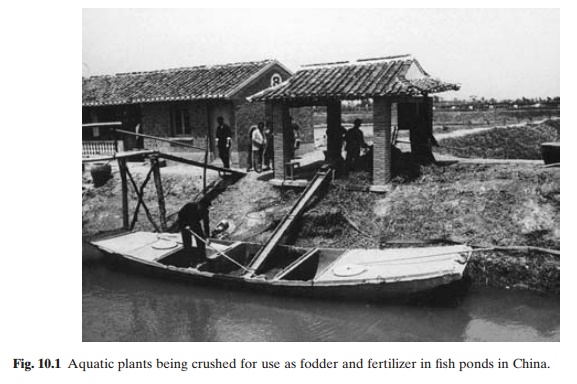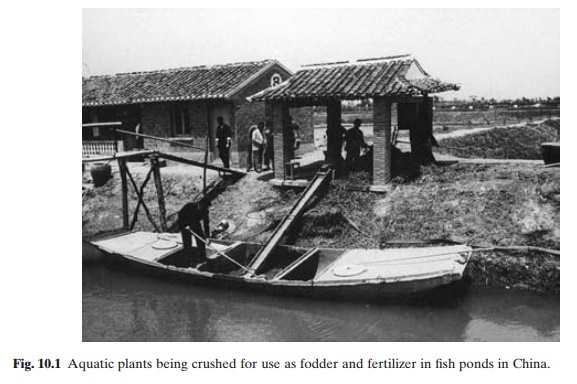Chapter: Aquaculture Principles and Practices: Control of Weeds, Pests and Predators
Prevention of infestations and utilization of weeds - Methods of weed control in Aquaculture

Methods of weed control
Prevention of infestations and utilization of weeds
It will be logical to consider first the possibility of preventing infestation of weeds in aquaculture farms. When constructing pond farms, care could be taken to avoid very shallow marginal areas and to maintain a depth of about 0.75– 0.9m around the shoreline, to discourage growth of marginal weeds. Accumulation of silt can be reduced by preventing drainage of run-off from fertile land areas and by regular desilting of ponds. Erecting barriers or mesh filters to prevent entry of noxious weeds and their spores or seeds can be of some help. The use of netting, treated with antifouling chemicals, to make cages may reduce to some extent the
growth of algal weeds in cage farms. But none of these preventive measures goes far enough to eliminate entirely the weed problem in aquaculture farms. So, it is often necessary to resort to one of the four other common control methods: manual, mechanical, chemical or biological.As will be discussed later, it will often be necessary to combine two or more of these methods to obtain satisfactory results.
The selection of the method of control has naturally to be based on the type and density of the infestation, the nature of the farm and the species that is cultured. Similarly, it is necessary to select the most appropriate time for treatment to get best results. Control measures are more effective if applied at the most vulnerable period in the life history of the weed, which is often the period of intensive production of reproductory units. For example, the best time to treat water hyacinth is during its active vegetative growth, when it is very susceptible. Plants with well-marked seasons of flowering or turion formation can best be cleared before the fruits, seeds or turions are fully formed and shed. Cutting of plants like water lilies (Nelumbium), Typha and Phragmites should be done when they are flowering.
Another major consideration in the selection of a method of weed control is the cost and naturally this varies very considerably between countries and locations. While estimating costs, the costs of not only the first major treatment, but also subsequent treatments have to be taken into account. By a combination of methods, such as manual and chemical, it may sometimes be possible to bring down the costs.
The cost of weed control can be reduced if some of the weeds can be put to productive use. Several efforts have been made to convert aquatic weeds to food, fertilizer, paper, fibre and energy (biogas). For comprehensive reviews of experience in this aspect Little (1968) and NAS (1976) may be consulted. Probably the two most convenient ways in which aquaculture can make use of aquatic weeds are as fertilizer or as fodder for herbivorous species. As will be described, the Chinese farmers have overcome the weed problem by their regular utilization of weeds as fodder for grass carp and other herbivores or as a fertilizer. Weeds collected from the farm and adjacent water bodies are finely crushed and introduced into ponds (fig. 10.1). Some of the material will be directly consumed by carps and the rest will fertilize the ponds for production

of the planktonic and benthic organisms on which fish fed.Another option is to compost the weeds and use them as fertilizer for the ponds or for terrestrial plants grown in association with the fish farm. The methods of composting were described. The weeds are harvested and spread out at the water’s edge for a day or two. The wilted plants are made into a pile with some soil, ash and a little animal manure. Microbial decomposition begins spontaneously and the resultant bacteria and fungi break down the lipids, proteins, sugars, starches and cellulose fibre. The heat retained by the composting mass encourages rapid multiplication of the microorganisms. Weeds growing in nutrientrich waters of aquaculture farms contain adequate quantities of nutrients to sustain the microbes that produce the compost. Frequent turning of the pile may be needed to maintain aerobic conditions. Weed seeds and most pathogenic bacteria are killed and the decomposed weeds become a soil-like compost.
Related Topics